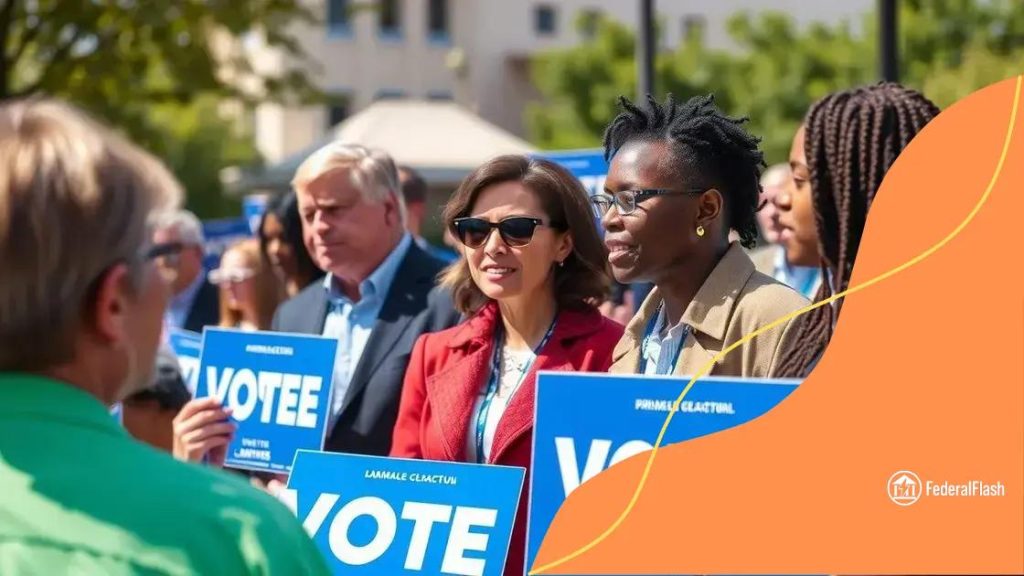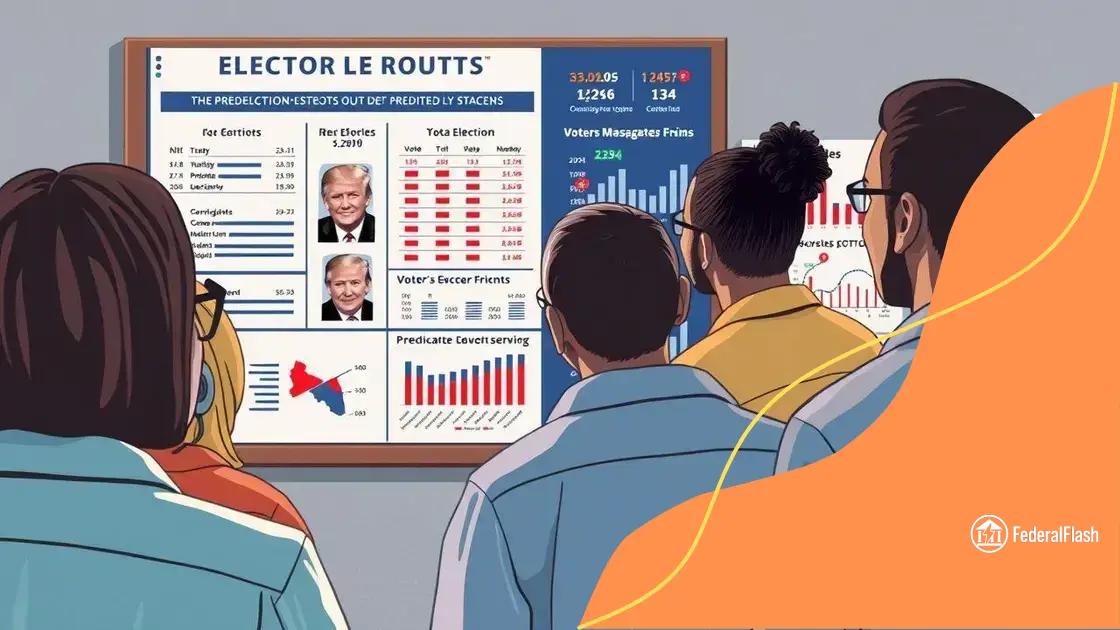What 2026 elections could bring: a closer look

Anúncios
The 2026 elections will present candidates with challenges such as funding, public scrutiny, and the need to engage diverse voter groups while navigating rapidly changing political landscapes.
What 2026 elections could bring is a topic ripe with speculation and significance. As we anticipate this crucial political event, questions arise about the potential shifts in power and policy that could affect daily lives.
Anúncios
Overview of the political landscape in 2026
The political landscape in 2026 is shaping up to be dynamic and unpredictable. As we look closer at how various factors influence this landscape, it’s important to understand what is at stake.
Current Trends
In recent years, we have seen significant shifts in political ideologies. Shifts among key demographics are influencing parties’ strategies. Issues like climate change, healthcare, and economic inequality are becoming more important to voters.
Key factors to watch
- Changing voter demographics
- Technology’s influence on campaigns
- Public opinion on social issues
- Economic conditions affecting electoral choices
As these factors unfold, the results may surprise many. The candidates’ ability to connect with their audience will greatly impact the elections. For instance, social media is playing a larger role than ever, allowing candidates to reach potential voters directly, bypassing traditional media.
Anúncios
Challenges Ahead
Despite the opportunities, candidates face various challenges. Misinformation is rampant, making it crucial for voters to discern fact from fiction. Additionally, external factors such as international relations and economic shocks can sway public opinion overnight.
As we approach the elections, it will be essential to observe how these challenges play out. The political landscape promises to change, with fresh faces and ideas emerging as key players. The electoral strategies will need to adapt accordingly.
Key issues impacting the upcoming elections
As the upcoming elections approach, several key issues are shaping the political conversation. Understanding these concerns is essential for voters and candidates alike.
Major Topics Influencing Voters
Voters are particularly concerned about economic recovery and job creation. The state of the economy often dictates the political climate, making this a priority.
Critical Areas of Focus
- Healthcare accessibility and affordability
- Climate change policies and their implementation
- Education reform and funding
- Social justice and equality movements
These topics are not just important; they resonate with the electorate. Candidates who address these issues may have a better chance of connecting with voters. Additionally, technology plays a vital role in how these issues are discussed and understood.
Social media platforms allow people to share their views quickly, making it crucial for candidates to respond appropriately. Each of these issues has unique contexts that can influence how voters perceive candidates and their policies.
Public Opinion Trends
The ongoing dialogue surrounding these issues highlights changing public opinions. Polls indicate shifting priorities among voters, impacting candidates’ platforms. For example, younger voters tend to prioritize climate change, while older generations might focus more on economic stability.
By understanding these dynamics, candidates can tailor their messages to resonate with the electorate. It’s evident that engaging in honest discussions about these key issues can significantly shift voter sentiment as we approach 2026.
Predicted outcomes and their implications

The predicted outcomes of the upcoming elections in 2026 will have profound implications for various sectors of society. As candidates present their platforms, it’s essential to analyze how these predictions might unfold.
Potential Electoral Outcomes
Many analysts suggest possible shifts in power dynamics. For instance, if a significant number of young voters participate, this could tilt the balance towards candidates focusing on progressive issues.
Key Factors Influencing Outcomes
- The impact of key issues on voter turnout
- Candidate charisma and public perception
- Endorsements from influential figures
- Grassroots movements mobilizing support
As these elements play a role, the result could reshape political landscapes in unexpected ways. Economic conditions leading up to the elections will also significantly influence voter sentiment. A strong economy may favor incumbents, while economic downturns could lead to a backlash against the ruling party.
Moreover, external events, such as international crises, may also sway public opinion quickly. As candidates address these issues, their responses will directly feed into how the electorate views their capability to lead.
Implications for Policy Changes
Should particular candidates win, significant policy changes could occur. For example, a focus on climate policies might intensify, leading to new regulations and funding for renewable energy. Alternatively, if conservative candidates prevail, there could be a push to roll back certain social programs.
Understanding these potential outcomes helps voters make informed decisions. As the 2026 elections approach, the implications will become clearer, emphasizing the weight of each vote in shaping the future.
Voices from the ground: public opinion
Public opinion is a crucial element in understanding how voters will act during the upcoming elections. As we near the 2026 elections, gathering diverse voices from the community becomes increasingly important.
Understanding Voter Sentiment
Recent surveys and polls indicate what the public cares about most. For many, issues such as the economy, healthcare, and education reform are at the top of their lists. This insight helps candidates tailor their messages effectively.
Key Concerns Among Voters
- Rising costs of living
- Access to quality healthcare
- Job security and employment opportunities
- The impact of climate change
Through social media and community forums, many voters express their views directly to candidates. This open communication allows individuals to share their thoughts and experiences, contributing to a broader understanding of public opinion.
Additionally, grassroots movements are becoming more influential, reflecting growing unity among specific groups. These movements focus on creating change in areas that matter deeply to them. Being heard is vital in a democracy, and these voices are essential for shaping campaigns.
Engaging with the Community
Candidates are now more likely to engage with constituents through town halls, social media, and community events. Listening to the needs and concerns of the people is becoming a standard practice, recognizing that feedback can influence policy decisions.
As the elections approach, it’s clear that public opinion will play a significant role in shaping political outcomes. With voters becoming more vocal, their perspectives are invaluable in guiding candidates and informing electoral strategies.
Hurdles candidates may face during campaigns
As candidates prepare for the upcoming elections, they will encounter multiple hurdles during their campaigns. Understanding these challenges is vital for their success and for those who follow the political landscape.
Key Challenges Faced by Candidates
One of the major obstacles is the funding of their campaigns. Candidates must secure enough resources to effectively compete, which can be difficult, especially for newcomers.
Additional Hurdles Include
- Negative advertising from opponents
- Public scrutiny of past actions and statements
- Gathering support from diverse voter groups
- Staying relevant amidst rapidly changing news cycles
Moreover, candidates often struggle with presenting their platforms clearly and convincingly. Voters need to understand their policies, and any confusion may lead to lost support. Timing is also critical; candidates must engage the public when their issues are most relevant.
Social media plays a double role in campaigning. While it offers a platform for outreach, it can also amplify negative messages quickly. Candidates must navigate this landscape carefully, responding to misinformation while promoting their agendas.
Navigating Voter Expectations
Often, the differences in voter expectations can create challenges. Candidates need to balance various interests, and failing to address specific concerns can alienate potential supporters. The public’s evolving views on key issues can add pressure to adapt campaign strategies in real-time.
Overall, awareness of these hurdles is essential for any candidate aiming to succeed in the complex landscape of the 2026 elections. Addressing these challenges effectively can determine their ability to connect with voters and achieve their electoral goals.
FAQ – Candidate Challenges in the 2026 Elections
What are the main hurdles candidates face during campaigns?
Candidates often struggle with securing sufficient funding, managing public scrutiny, and engaging with diverse voter groups.
How can candidates effectively engage with voters?
Candidates can use social media, host community events, and participate in town hall meetings to connect with constituents.
What role do grassroots movements play in elections?
Grassroots movements can amplify a candidate’s message and mobilize support for key issues, reflecting voters’ concerns.
How important is adapting to changing voter expectations?
Adapting to evolving voter issues is crucial; candidates who address current concerns are more likely to resonate with the electorate.